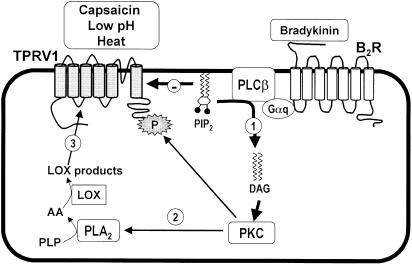Figure 6.
Proposed mechanisms involved in BK-induced activation of TRPV1. As discussed, the current results provide consistent in vivo experimental evidence supporting the concept that, at least in part, the nociception caused by i.pl. injection of BK into the mouse paw is indirectly mediated by both activation and sensitization of TRPV1 receptor. BK, by acting at protein Gq coupled B2 receptors, is able to stimulate PLCβ that in turn produces hydrolysis of the plasma membrane phospholipid PIP2, exerting an inhibitory action on TRPV1 channel function (step 1). Furthermore, after stimulation of neurons with B2 receptor agonists such as BK, a rapid formation of diacylglycerol (DAG) occurs that in turn induces phosphorylation of key targets through PKC-mediated mechanisms (step 2). The third proposed mechanism involves the ability of BK to induce the activation of PLA2 and generation of endogenous LOX-derived products that act directly to stimulate the TRPV1 receptor (step 3).

